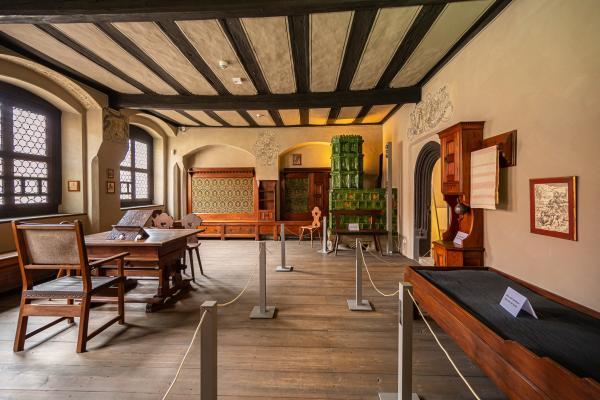UNESCO Melanchthon House
The Melanchthon House is considered one of the most beautiful town houses in Lutherstadt Wittenberg and served as the residence of the scholar Philipp Melanchthon.
Philipp Melanchthon was, along with Martin Luther, the most important church political actor and theological author of the Wittenberg Reformation. The Melanchthon House is the building where he lived with his family and many guests from 1539. Here he composed many of his writings and also conducted poetic competitions with his students. Nowhere can you get closer to Melanchthon than in his house, which has almost never been rebuilt over the centuries and is therefore the most important exhibit within the current permanent exhibition on the life and work of the humanist and reformer. With illustrations and recreated everyday objects, visitors get an impression of the life and everyday life of the famous university professor and his family.
The exhibition section in the new annex is devoted entirely to Melanchthon's work and impact. Manuscripts, prints, paintings and busts are exhibited here. Some of the exhibits have never been presented to the public before, including an original salary receipt of the professor or the first city history of Wittenberg, which Melanchthon wrote in handwriting. Works and letters by Melanchthon and his contemporaries, such as the momentous "Confessio Augustana," the Augsburg Confession (fundamental defense of the Reformation) of 1530, are set in the contexts of Reformation theology and the development of Protestantism. One of the central exhibits is a larger-than-life portrait of Melanchthon by Lucas Cranach the Younger, which was lavishly restored for the exhibition.
The younger guests have also been thought of. Thus elements are integrated into the exhibition, which were developed particularly for children and young people. At the entrance, children are given a cast-iron key that gives them access to chests and cabinets with hidden games, and also unlocks hidden media stations specifically aimed at children. The complex historical material of the Reformation story is told from the perspective of Magdalena, Melanchthon's ten-year-old daughter. She guides visitors through the exhibition with graphic images and her voice and provides information about living and working conditions in the Melanchthon household.
The herb garden behind the house, laid out according to historical models - in which medicinal plants also grow in the tradition of the herbalist scholar - invites young and old to linger after their visit to the museum.






Opening hours
April 1 - October 31:
Mon - Sun 10:00 - 18:00
November 1 to March 31:
Tue - Sun 10:00 - 17:00
